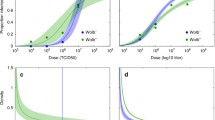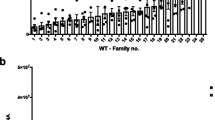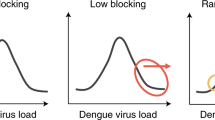Abstract
Lines of Aedes aegypti mosquitoes infected with heritable Wolbachia bacteria are being developed and released for arbovirus control. Coordinated releases of lab-reared Wolbachia mosquitoes have reduced local disease incidence by spreading virus-blocking Wolbachia strains and by crashing mosquito populations through incompatible male releases. The phenotypic effects of Wolbachia are diverse and depend on both genetics and the environment. Accurate assessments of Wolbachia effects in mosquitoes are essential, as such effects can make the difference between success and failure of a Wolbachia release program. This chapter provides guidelines for testing key Wolbachia host effects and transmission in Aedes aegypti: the most important arbovirus vector and the most common target of Wolbachia release programs. The protocols should be useful for evaluating mosquito strains prior to field release.
Access this chapter
Tax calculation will be finalised at checkout
Purchases are for personal use only
Similar content being viewed by others
References
Ritchie SA, Johnson BJ (2017) Advances in vector control science: rear-and-release strategies show promise... But don’t forget the basics. J Infect Dis 215(suppl_2):S103-S8
Caragata EP, Dutra HLC, Sucupira PHF et al (2021) Wolbachia as translational science: controlling mosquito-borne pathogens. Trends Parasitol 37(12):1050–1067
Shropshire JD, Leigh B, Bordenstein SR (2020) Symbiont-mediated cytoplasmic incompatibility: what have we learned in 50 years? elife 9:e61989
Zheng X, Zhang D, Li Y et al (2019) Incompatible and sterile insect techniques combined eliminate mosquitoes. Nature 572:56–61
Beebe NW, Pagendam D, Trewin BJ et al (2021) Releasing incompatible males drives strong suppression across populations of wild and Wolbachia-carrying Aedes aegypti in Australia. Proc Natl Acad Sci U S A 118(41)
Schmidt TL, Barton NH, Rasic G et al (2017) Local introduction and heterogeneous spatial spread of dengue-suppressing Wolbachia through an urban population of Aedes aegypti. PLoS Biol 15(5):e2001894
Ant TH, Mancini MV, McNamara CJ et al (2022) Wolbachia-virus interactions and arbovirus control through population replacement in mosquitoes. Pathog Glob Health:1–14
Nazni WA, Hoffmann AA, NoorAfizah A et al (2019) Establishment of Wolbachia strain wAlbB in Malaysian populations of Aedes aegypti for dengue control. Curr Biol 29(24):4241–8 e5
Utarini A, Indriani C, Ahmad RA et al (2021) Efficacy of Wolbachia-infected mosquito deployments for the control of dengue. N Engl J Med 384(23):2177–2186
Hoffmann AA, Turelli MJ (1997). Cytoplasmic incompatibility in insects. Influential passengers: inherited microorganisms and arthropod reproduction. pp 42–80
Zeng Q, She L, Yuan H, Luo Y et al (2022) A standalone incompatible insect technique enables mosquito suppression in the urban subtropics. Commun Biol 5(1):1–13
Nguyen TH, Nguyen HL, Nguyen TY et al (2015) Field evaluation of the establishment potential of wMelPop Wolbachia in Australia and Vietnam for dengue control. Parasit Vectors 8:563
Yeap HL, Mee P, Walker T et al (2011) Dynamics of the "popcorn" Wolbachia infection in outbred Aedes aegypti informs prospects for mosquito vector control. Genetics 187(2):583–595
McMeniman CJ, Lane RV, Cass BN et al (2009) Stable introduction of a life-shortening Wolbachia infection into the mosquito Aedes aegypti. Science 323(5910):141–144
Garcia GA, Sylvestre G, Aguiar R et al (2019) Matching the genetics of released and local Aedes aegypti populations is critical to assure Wolbachia invasion. PLoS Negl Trop Dis 13(1):e0007023
Ross PA, Turelli M, Hoffmann AA (2019) Evolutionary ecology of Wolbachia releases for disease control. Annu Rev Genet 53(1):93–116
Hoffmann AA, Ross PA, Rašić G (2015) Wolbachia strains for disease control: ecological and evolutionary considerations. Evol Appl 8(8):751–768
Zhou W, Rousset F, O’Neil S (1998) Phylogeny and PCR-based classification of Wolbachia strains using wsp gene sequences. Proc B Biol Sci 265(1395):509–515
Lee SF, White VL, Weeks AR et al (2012) High-throughput PCR assays to monitor Wolbachia infection in the dengue mosquito (Aedes aegypti) and Drosophila simulans. Appl Environ Microbiol 78(13):4740–4743
Goncalves DDS, Hooker DJ, Dong Y et al (2019) Detecting wMel Wolbachia in field-collected Aedes aegypti mosquitoes using loop-mediated isothermal amplification (LAMP). Parasit Vectors 12(1):404
Anderson LE (1954) Hoyer’s solution as a rapid permanent mounting medium for bryophytes. Bryologist 7(3):242–244
Lau M-J, Ross PA, Hoffmann AA (2021) Infertility and fecundity loss of Wolbachia-infected Aedes aegypti hatched from quiescent eggs is expected to alter invasion dynamics. PLoS Negl Trop Dis 15(2):e0009179
Nevalainen LB, Newton IL (2023) Detection and assessment of Wolbachia pipientis infection. Drosophila Oogenesis: Methods and Protocols: Springer, pp 291–307
Costa-da-Silva AL (2022) Artificial membrane feeding mosquitoes in the laboratory with glytube. Cold Spring Harbor Protocols
Faber PA, Dorai AJ, Chown SL (2022) A standardised low-cost membrane blood-feeder for Aedes aegypti made using common laboratory materials. PeerJ 10:e14247
Walker T, Johnson PH, Moreira LA et al. The wMel Wolbachia strain blocks dengue and invades caged Aedes aegypti populations. Nature 476(7361):450–453
Xi Z, Khoo CC, Dobson SL (2005) Wolbachia establishment and invasion in an Aedes aegypti laboratory population. Science 310(5746):326–328
Hoffmann AA, Montgomery BL, Popovici J et al (2011) Successful establishment of Wolbachia in Aedes populations to suppress dengue transmission. Nature 476(7361):454–457
Dobson SL, Rattanadechakul W (2001) A novel technique for removing Wolbachia infections from Aedes albopictus (Diptera: Culicidae). J Med Ent 38(6):844–849
Author information
Authors and Affiliations
Corresponding author
Editor information
Editors and Affiliations
Rights and permissions
Copyright information
© 2024 The Author(s), under exclusive license to Springer Science+Business Media, LLC, part of Springer Nature
About this protocol
Cite this protocol
Ross, P.A. (2024). Measuring Host Fitness Effects and Transmission of Wolbachia Strains in Aedes aegypti Mosquitoes. In: Fallon, A.M. (eds) Wolbachia. Methods in Molecular Biology, vol 2739. Humana, New York, NY. https://doi.org/10.1007/978-1-0716-3553-7_12
Download citation
DOI: https://doi.org/10.1007/978-1-0716-3553-7_12
Published:
Publisher Name: Humana, New York, NY
Print ISBN: 978-1-0716-3552-0
Online ISBN: 978-1-0716-3553-7
eBook Packages: Springer Protocols




